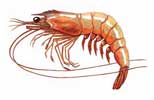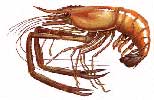In the USA, people commonly call large shrimp "prawns", but that's not correct because some prawns can be smaller than shrimp. Some people think shrimp are saltwater and prawns are freshwater. That's not correct either.
This is the difference:
- The structure of the gills is different between shrimp and prawns. If you turn a shrimp over and look at its "belly", the side plate of the second segment of the abdomen overlaps the segments in the front and behind. If you do the same to a prawn, all of the abdominal side plates overlap like tiles from the front.
- Shrimp "brood" their eggs like a chicken (the eggs are held in their swimming legs -- See http://en.wikipedia.org/wiki/Pleopod). Prawns don't brood -- They just shed their eggs into the current.
In Thailand, there are mainly three types of "prawns" served in restaurants:
- กุ้งแชบ๊วย Goong Chae-biao (White Prawn, Banana Prawn) Penaeus merguiensis - It has a white body with small rust-colored dots. Fully grown, they obtain a length of 20 cm (8 inches) or more, but they are harvested before they reach half that size. The small ones are sorted and sold as กุ้งชีแฮ้ Goong Chee-Hae. This is the prawn that is found in recipes that just indicate "prawns".

- กุ้งกุลาดำ Goong Goo-Laa-Dum (Tiger Prawn) Penaeus monodon - It has black and white stripes and is the giant among Asia prawns. The females grow to over 30 cm (1 foot) long. Look at the size of these tiger prawns!

- กุ้งก้ามกราม Goong Gaam-graam (Spiny-Clawed Prawn, Giant Freshwater Prawn, Freshwater Lobster) Macrobrachium rosenbergii - These are the prawns with the long second walking leg and a large spiny pincher. Spiny-clawed prawns with blue bodies are more tender when broiled or baked than those with grey-green bodies. Smaller spiny-clawed prawns are called กุ้งนาง Goong Naang.

No comments:
Post a Comment